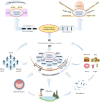Genetic Landscape of Obesity in Children: Research Advances and Prospects
- PMID: 40689079
- PMCID: PMC12274101
- DOI: 10.1155/jobe/9186826
Genetic Landscape of Obesity in Children: Research Advances and Prospects
Abstract
Obesity is a chronic metabolic disease characterized by excessive accumulation or uneven distribution of fat in the body, which poses a serious threat to health. Obesity significantly increases the risk of developing сonditions such as type 2 diabetes, coronary heart disease, hypertension, obstructive sleep apnea, and some types of cancer. The prevalence of obesity, especially in childhood, has increased significantly worldwide over the past few decades. The World Health Organization predicts that 250 million children and adolescents aged 5-19 years will be obese by 2030, which indicates a global problem with far-reaching consequences. Advances in genomic technologies have led to the identification of multiple genetic loci associated with the disease ranging from severe cases with early onset to common multifactorial polygenic forms. Epigenetic changes driven by dietary and lifestyle factors are now recognized as crucial contributors to obesity. These modifications can alter gene expression and thereby link environmental influences to the observable clinical features of the disease. Significant progress has been made in deciphering the genetic architecture of obesity, particularly in pediatric populations. However, further advancement requires integrative multiomics analyses that encompass genomic, epigenomic, transcriptomic, proteomic, metabolomic, and microbiome data. To better understand the complex molecular underpinnings and clinical variability of obesity, researchers are increasingly applying methods from machine learning and artificial intelligence. These technologies help analyze large-scale genomic and phenotypic datasets, allowing for the identification of biological pathways involved in weight regulation. In the future, this may support the design of individualized diagnostic tools and targeted treatment plans that reflect a patient's genetic profile, lifestyle, and environmental exposures. To implement the principles of personalized and precision medicine in the treatment of obesity, it is crucial to identify risk profiles by assessing multiple contributing factors. This approach not only enables the prediction of an individual's risk of obesity and its associated diseases but also facilitates the optimization of treatment based on the patient's genetic profile. This study provides a comprehensive overview of the current understanding of childhood obesity, including its prevalence, genetic determinants, and pathophysiological mechanisms. It highlights the contribution of genetic factors to hereditary and syndromic forms, the role of gene-environment interactions (including nutrition and environmental pollutants), and the influence of epigenetic modifications on metabolic disturbances associated with polygenic obesity.
Keywords: childhood obesity; epigenetics; genetic factors; gene–environment interactions; monogenic obesity; polygenic obesity; syndromic obesity.
Copyright © 2025 Rita Khusainova et al. Journal of Obesity published by John Wiley & Sons Ltd.
Conflict of interest statement
The authors declare no conflicts of interest.
Figures



References
Publication types
MeSH terms
LinkOut - more resources
Full Text Sources
Medical
Miscellaneous

